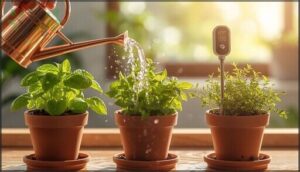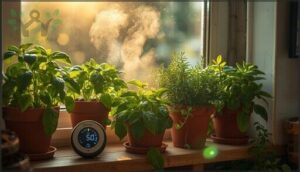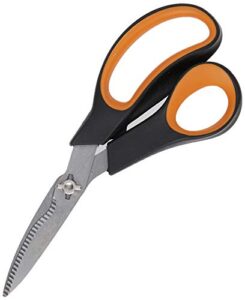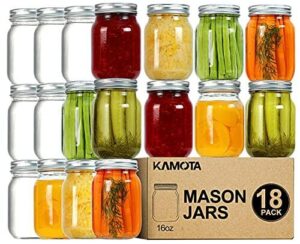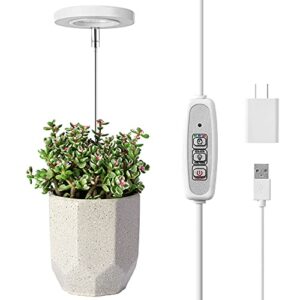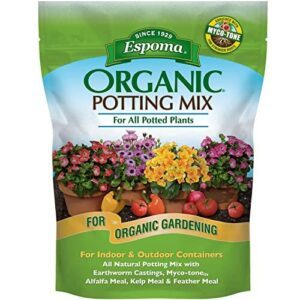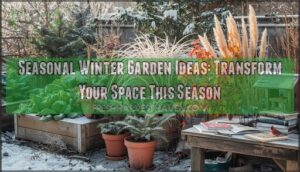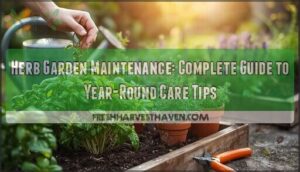This site is supported by our readers. We may earn a commission, at no cost to you, if you purchase through links.
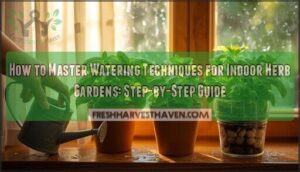
Most indoor herb gardens don’t fail from neglect—they drown from too much attention. You water your basil daily, convinced you’re being a diligent plant parent, only to watch the leaves yellow and the stems turn mushy at the base. The problem isn’t your dedication; it’s that watering indoor herbs requires a completely different approach than caring for outdoor plants or typical houseplants.
Herbs grown indoors face unique challenges: limited drainage, inconsistent humidity, and soil that behaves unpredictably in containers. Getting the water balance right means understanding not just when to water, but how to water, what water to use, and how your indoor environment affects every drop.
Once you learn to read your herbs’ actual needs and match your technique to their growing conditions, you’ll stop guessing and start growing thriving plants that produce fresh flavor all year long.
Table Of Contents
- Key Takeaways
- Choosing The Right Water for Herbs
- Determining Ideal Watering Frequency
- Best Watering Techniques for Indoor Herbs
- Preventing Overwatering and Root Rot
- Managing Humidity and Indoor Environment
- Growing Herbs in Water Indoors
- Top 9 Products for Watering Indoor Herb Gardens
- 1. Clear Glass Cylinder Vases Set
- 2. Fiskars Soft Grip Garden Shears
- 3. Kamota 16 Oz Mason Jars
- 4. SunBlaster Black Grow Light Garden
- 5. Lordem Full Spectrum LED Grow Light
- 6. Espoma Organic Potting Soil Mix
- 7. Ziyad Premium Green Za’atar Spice Blend
- 8. Fu Dog Garden Fresh Lemongrass Stalks
- 9. Corona Flex Dial Comfort Grip Pruner
- Frequently Asked Questions (FAQs)
- Conclusion
Key Takeaways
- Most indoor herbs fail from overwatering rather than neglect, so you should check soil moisture 1-2 inches deep with your finger instead of following a fixed schedule, adjusting frequency based on pot size, herb type, and seasonal changes.
- Water quality matters significantly for herb health—filtered or room-temperature rainwater (pH 6.0-7.0) prevents chemical buildup and mineral toxicity better than tap water, which often contains chlorine, fluoride, and heavy metals that stress sensitive plants.
- Bottom watering promotes deeper root development and prevents fungal diseases by keeping foliage dry, while proper drainage with 3-5 holes and well-draining soil mixed with perlite reduces root rot risk by up to 40%.
- Maintaining 40-60% indoor humidity with adequate airflow prevents both excessive transpiration in dry conditions and fungal infections in overly moist environments, making humidity management as critical as watering technique itself.
Choosing The Right Water for Herbs
Regarding watering your indoor herbs, the type of water you use matters more than you might think. Different sources can affect growth, flavor, and overall plant health. Here’s what you need to know before you start watering.
Tap Vs. Filtered Water
Even though tap water is convenient, its contaminants—like chlorine, fluoride, and excess minerals—can quietly sabotage herb health and growth rates. Switching to filtered water offers clear filtration benefits, supporting better water quality and easier water preparation for your indoor herb garden. Using filtered water can help prevent brown leaf tips on sensitive plants.
If you’re aiming for mastery, consider:
- Reduced chemical buildup
- Stronger root development
- Consistent, vibrant foliage
Effects of Water Quality on Herbs
Water quality shapes everything from nutrient absorption to flavor. Your herbs thrive when water pH levels stay between 6.0 and 7.0, where roots can access essential minerals.
Tap water with high mineral content effects growth negatively, while disinfectant impact from chlorine or chloramine stresses sensitive plants. Heavy metal uptake becomes a real concern with contaminated water sources.
Greywater considerations? Skip it entirely for edible herbs—pathogens transfer too easily. Municipal water often contains chlorine, but the levels are typically safe for most plants.
Using Rainwater or Distilled Water
Beyond filtered water, your water sources expand to include rainwater and distilled water. Rainwater benefits herbs greatly—it’s naturally soft, chemical-free, and contains plant-available nitrogen that promotes healthy growth.
Here are key user practices to keep in mind:
- Collect rainwater in clean containers away from lead surfaces
- Store at room temperature to prevent root shock
- Filter or test for pathogens before use
- Use distilled water for mineral-sensitive herbs
- Alternate between both based on availability
Distilled drawbacks? It lacks mineral content entirely, so you’ll need regular fertilization. Safety concerns with rainwater involve proper storage and contamination prevention.
Avoiding Harmful Chemicals in Water
Your water quality matters more than you might realize. Tap water can contain chlorine, fluoride, heavy metals, and even PFAS contamination—those “forever chemicals“ found in nearly half of U.S. tap water samples.
Chlorine dissipation happens naturally when you let water sit uncovered for 24 hours, reducing concentrations by up to 90%. For better filtration efficacy against organic residues, activated carbon filters remove over 95% of harmful contaminants, giving your herbs cleaner, safer hydration.
Determining Ideal Watering Frequency
Getting your watering schedule right can feel like a guessing game at first, but it doesn’t have to be. Your herbs will tell you what they need once you know what to look for.
Here’s what affects how often you should reach for that watering can.
Factors Affecting Watering Needs
Your herbs don’t all drink the same way. Watering frequency depends on several environmental factors working together: container volume, humidity levels, evaporation rates, and the specific plant species you’re growing.
Smaller pots dry faster, while higher humidity slows soil moisture loss.
Different herb types have distinct root health needs—some prefer consistently moist conditions, others thrive when allowed to dry between waterings. Understanding these variables helps you water smarter.
How to Check Soil Moisture
How do you really know when your indoor herb garden needs watering? Manual inspection remains the best practice—stick your finger 1–2 inches into the soil to feel its dryness.
Electronic sensors offer real-time readings on a 1–10 scale for under $20, making monitoring soil moisture levels easier.
Check weekly at minimum, increasing to every 2–3 days during active growth to maintain ideal moisture thresholds.
Adapting to Pot Size and Herb Type
When you pair smaller pots with water-loving herbs like basil, you’ll need to check moisture every 3–4 days since containers under 1 gallon dry out rapidly. Root depth plays a key role—shallow-rooted herbs demand consistent attention, while deeper systems tolerate longer intervals between waterings.
Mediterranean varieties such as rosemary thrive in larger 12-inch pots, requiring watering just once weekly.
Adjusting for Climate and Seasons
Your indoor herbs shift their thirst dramatically as seasons change—summer heat can push watering frequency up by 40–70% compared to winter’s slower pace. When temperatures climb above 79°F, transpiration rates jump over 30%, demanding closer attention.
Winter dormancy in Mediterranean varieties like rosemary cuts water needs by half, while low humidity below 35% accelerates evaporation and may require daily monitoring to prevent leaf desiccation.
Best Watering Techniques for Indoor Herbs
Once you’ve figured out how often to water your herbs, the next step is choosing how you’ll deliver that moisture. The method you use can make the difference between thriving plants and ones that struggle with uneven watering or leaf problems.
Let’s look at the most effective techniques to keep your indoor herbs consistently healthy.
Bottom Watering Vs. Top Watering
Think of watering techniques as choosing between two paths for your indoor herb garden. Top watering works quickly and flushes away salt accumulation from tap water, but it risks overwatering issues and fungal risk on wet foliage.
Bottom watering promotes deeper root development and keeps leaves dry, though you’ll need to occasionally top-water to prevent mineral buildup in the soil surface.
Using Watering Cans and Self-watering Systems
Watering can design matters more than you’d think. A fine rose attachment spreads water gently across your herb pots, reducing soil erosion and preventing dry spots in containers under six inches.
Self-watering planters cut your watering frequency to once every week or two, improving water-use efficiency by roughly 30% while promoting healthier root development—though drainage remains essential to prevent root rot.
Tips for Even Moisture Distribution
Once you’ve settled on your watering tools, consistent hydration depends on technique. Soil moisture sensors improve water-use efficiency by up to 20%, helping you avoid dry pockets.
Water evenly until drainage flows freely, rotate containers weekly for balanced growth, and space pots 2–3 inches apart to support airflow.
Individual herb pots let you fine-tune watering frequency without competing root systems creating dry zones.
Avoiding Water on Foliage to Prevent Mildew
Beyond even moisture, keeping leaves dry is your first line of defense against fungal diseases. Over 85% of powdery mildew cases occur when foliage stays wet for more than six hours and humidity tops 85%.
Water at soil level each time, aim for early morning watering timing to encourage foliage drying, and maintain air circulation with proper spacing—these habits make mildew prevention simple.
Preventing Overwatering and Root Rot
Overwatering is one of the most common mistakes that can quickly damage your indoor herb garden. When roots sit in soggy soil for too long, they can’t breathe, leading to root rot and yellowing leaves.
Let’s look at how to spot the warning signs early and fix drainage problems before they harm your herbs.
Signs of Overwatered Herbs
When overwatering strikes, your herbs send clear distress signals. Yellowing leaves, especially lower ones, appear first—often with mushy stems that feel soft to the touch.
You’ll notice a stale soil odor from low oxygen conditions, and edema lesions may form as blisters on leaves.
The most serious sign is root rot: brown, foul-smelling roots that signal fungal diseases have taken hold.
Improving Drainage With Containers and Soil
Once you’ve spotted those warning signs, the fix starts with proper drainage. Choose containers with at least 3-5 drainage holes at the bottom—this simple step cuts root rot risk by up to 40%. Go for porous materials like clay or wood to encourage airflow.
Your soil composition matters just as much: sandy loam with a pH between 6.1 and 7.0 drains quickly without compacting. Mix in perlite or coarse sand to boost water movement by 35%, and skip gravel layers—they actually trap water rather than help it escape.
Monitoring Soil Wetness
To stay ahead of both overwatering and underwatering, you’ll need reliable measurement practices. Capacitive soil moisture sensors deliver 3%-5% accuracy after sensor calibration, giving you real-time data on wetness ranges—most herbs thrive between 21% and 40% volumetric water content.
- Check moisture 2-3 inches down where root health depends on consistent hydration
- Use monitoring technologies like FDR sensors for ±1%-3% precision
- Set alerts when readings drift outside ideal soil moisture levels
- Test multiple spots in larger containers to catch uneven watering techniques
- Replace basic sensors every 1-3 years to maintain accuracy
Steps to Recover From Overwatering
When you notice signs of overwatering, start with root assessment. Trim any brown, soft tissue with sterilized tools to prevent root rot.
Next, focus on soil drying by increasing airflow and elevating the container for better drainage. If damage is severe, repotting herbs into a fresh, well-draining mix helps.
Apply fungicide treatments if needed, then adjust watering techniques based on actual moisture levels.
Managing Humidity and Indoor Environment
Your indoor environment plays a bigger role in herb health than you might think. Humidity levels and air circulation affect how your herbs absorb water, fight off disease, and develop strong leaves.
Let’s look at the key factors you need to manage for thriving indoor herbs.
Role of Humidity in Herb Health
Think of humidity as the invisible conductor of your indoor herb garden—it orchestrates how efficiently your plants breathe, feed, and fight off disease. Here’s what you need to understand about maintaining indoor humidity and its role in your garden’s success:
Humidity is the invisible conductor of your indoor herb garden, orchestrating how efficiently your plants breathe, feed, and fight disease
- Transpiration rates surge when humidity drops below 40%, causing your herbs to lose water faster and wilt
- Nutrient uptake reaches peak efficiency between 40–60% humidity, enhancing flavor and growth
- Disease prevention improves by 40% when you keep humidity around 50%
- Watering adjustments become necessary—low humidity demands 20–30% more frequent watering
- Humidity effects on root health mean levels above 65% increase root rot risk by 38%
Understanding these connections helps you master watering techniques for herbs while preventing common problems before they start.
Maintaining Optimal Indoor Humidity
You’ll want to aim for 40–60% humidity in your indoor herb garden, with 50% hitting the sweet spot. Use a digital hygrometer to track levels—they’re accurate within ±2%.
During winter heating, expect drops below 35%, so run a cool-mist humidifier or group plants together to boost humidity by 10–15%.
In summer, high humidity above 65% invites fungal trouble, so ventilate accordingly.
Improving Airflow Around Herbs
Proper air circulation acts like a gentle breeze through your herbs, whisking away humidity pockets where fungal growth thrives. Place a small oscillating fan 3–5 feet away to create constant airflow without directly blasting foliage.
Space pots 4–6 inches apart—research shows this accelerates drying after watering by increasing evaporation rates. Good plant spacing paired with fan placement dramatically improves disease prevention while supporting healthy gas exchange.
Preventing Fungal Infections
Fungal infections stem from excess moisture—overwatering paired with poor airflow creates a breeding ground for root rot and leaf mildew. Combat this with proven strategies:
- Water at soil level to cut foliar fungal risk by 55%
- Keep humidity between 40–60% using proper ventilation
- Apply neem oil treatments (92% fungal growth reduction)
- Use well-draining container design with drainage holes
- Check weekly for early detection of discoloration or spots
Growing Herbs in Water Indoors
Growing herbs in water is one of the easiest ways to keep fresh flavors at your fingertips without worrying about soil or mess. You can propagate many common herbs directly in water, and they’ll thrive for weeks or even months with minimal effort.
Let’s look at which herbs work best in water, what containers to use, and how to get started with this simple growing method.
Herbs Suitable for Water Propagation
Soft-stemmed herbs like basil, mint, and oregano root easily in water, showing success rates above 80% when you use 8–10 cm cuttings. Woody herbs, such as rosemary and thyme, are trickier—they take 4–6 weeks and prefer semi-soft stems.
For long-term culture, basil and mint thrive for months, while environmental factors like light and regular water changes boost rooting success across all plant cuttings.
Containers for Water-based Herb Gardening
Once you’ve picked your herbs, you’ll need the right vessel. Glass jars—clear or amber—are popular for water-based herb cultivation because they let you monitor roots while controlling algae. Containers between 500 mL and 800 mL support vigorous growth, and frosted designs reduce light transmission by 60% to keep water cleaner.
Consider these practical points when choosing herb containers:
- Wide mouths improve airflow and cut humidity buildup by 30%
- Opaque materials fight algae, slashing growth by 45%
- Deeper vessels (15+ cm) prevent tipping as roots mature
Steps for Propagating Herbs in Water
Now that you’ve got your containers, you can start herb propagation. Take cuttings 4 to 6 inches long from soft-stemmed herbs, snipping at a 45° angle just above a leaf node. Strip off leaves that’ll sit underwater, rinse each cutting, then submerge it in clean, room-temperature water.
Change the water every 2–3 days and watch for roots within 1–3 weeks.
Harvesting and Caring for Water-grown Herbs
Once roots emerge and your cuttings mature—usually around day 30—you’re ready to harvest. Trim mature leaves or stems above a leaf node using clean scissors, taking no more than one-third at a time.
Change the nutrient solution weekly, monitor pH levels between 5.5 and 6.8, and keep the system clean by removing debris. These rejuvenation practices and proper post-harvest care keep your water-based herb cultivation thriving for months.
Top 9 Products for Watering Indoor Herb Gardens
The right tools make watering your indoor herb garden easier and more effective. From containers that support water propagation to equipment that helps you maintain healthy plants, having quality supplies on hand sets you up for success.
Here are nine products that’ll help you grow thriving herbs indoors.
1. Clear Glass Cylinder Vases Set
When you’re growing herbs in water, clear glass cylinder vases offer a unique advantage: you can watch root development unfold right before your eyes. This root visibility lets you spot issues like algae buildup or unhealthy roots early on.
The ideal size—around 3.5 inches wide and 6 inches tall—accommodates most water-propagated herbs like basil, mint, and oregano beautifully. Just keep in mind that algae management matters with transparent containers, so you’ll need to clean them regularly.
These vases make watering your indoor herb garden straightforward while supporting strong growth impact through proper hydroponic conditions.
Best For: Indoor gardeners who want to propagate herbs like basil, mint, and oregano in water while monitoring root health and water levels at a glance.
- Clear glass lets you track root development and catch problems like algae or disease early without disturbing the plant
- The 3.5″ x 6″ size works well for most herb cuttings, giving roots enough space to grow for several weeks before transplanting
- Comes as a set of 12, so you can rotate different herbs or stagger plantings for continuous harvest year-round
- Transparent glass encourages algae growth in bright light, requiring cleaning every couple of weeks to keep roots healthy
- Glass is fragile and some customers report receiving broken or dirty vases due to shipping issues
- You’ll need to rinse them thoroughly before first use since they may arrive with dust or residue
2. Fiskars Soft Grip Garden Shears
When harvesting herbs from your indoor herb garden, precision matters—the Fiskars Soft Grip shears deliver that with their hardened stainless steel blade material and serrated edges that grip slippery stems cleanly. Their take-apart feature simplifies cleaning methods after contact with herb sap, which preserves cutting performance over time.
The ergonomic design reduces hand fatigue by about 40% compared to straight-handle models, making frequent trimming comfortable. Though proper watering techniques nourish your plants, these shears enable selective harvesting without crushing stems.
Just note the safety features: store them carefully to avoid exposed blade edges.
Best For: Home gardeners who want comfortable, precise herb trimming tools that reduce hand strain during frequent harvesting sessions.
- Serrated stainless steel blades grip and cut cleanly through slippery herb stems without crushing delicate plant tissue
- Ergonomic SoftGrip handles reduce hand pressure by roughly 40% compared to straight-handle shears, making extended trimming comfortable
- Take-apart design allows thorough cleaning after each use, preventing sap buildup that can dull blades or cause sticking
- The twist-and-unlock mechanism can sometimes disengage unexpectedly during use, interrupting your work
- Newer models may show reduced durability and require replacement within a year of regular use
- Blades can rust or stick if not properly dried and maintained after cleaning, especially in damp indoor environments
3. Kamota 16 Oz Mason Jars
You’ll find Kamota 16 oz mason jars strike that perfect balance between aesthetic appeal and cost-effectiveness for your indoor herb garden—the jar size accommodates basil, cilantro, and mint comfortably while fitting most windowsills.
Since these lack drainage holes, layer 1 to 2 inches of gravel at the bottom as your drainage solution before adding soil. This setup facilitates both traditional planting and herb propagation techniques in water.
At roughly $1 per jar in multi-packs, they’re herb-compatible vessels that make watering management straightforward when you monitor moisture levels carefully.
Best For: Budget-conscious gardeners who want to grow small kitchen herbs like basil, parsley, and mint on windowsills without investing in specialized planters.
- Cost-effective at around $1 per jar when bought in multi-packs, making it easy to start multiple herbs without breaking the bank.
- Lead-free, BPA-free glass construction keeps your edible herbs safe and the jars reusable for years.
- The 16 oz size fits nicely on most windowsills while giving herbs enough room to grow for about 6 weeks until maturity.
- No drainage holes means you’ll need to add gravel layers and watch your watering carefully to avoid root rot.
- Some customers report receiving jars with poor lid seals or quality issues, plus mixed experiences with customer service for replacements.
- The actual size can feel smaller than expected, and durability varies with reports of jars breaking during shipping or regular use.
4. SunBlaster Black Grow Light Garden
When you’re serious about growing herbs year-round, the SunBlaster Black Grow Light Garden brings professional-grade lighting spectrum (6400K) to your countertop—ideal for basil, parsley, and cilantro’s vegetative growth needs.
Its energy efficiency shines at 3.08 μmol/m²/s/Watt, and the built-in wick watering system means you won’t stress about daily moisture checks.
While some users find the light bar adjustment tricky, this setup’s herb suitability and cost analysis reveal strong long-term value for indoor herb gardening enthusiasts committed to mastering both lighting and watering fundamentals.
Best For: Home gardeners who want to grow herbs indoors year-round with professional-quality lighting and minimal daily watering effort.
- 6400K spectrum delivers excellent light for leafy herbs like basil, cilantro, and parsley with high energy efficiency (3.08 μmol/m²/s/Watt)
- Built-in wick watering system keeps plants hydrated for up to 14 days, reducing daily maintenance
- Long-lasting LEDs (50,000 hours) mean over 11 years of operation before replacement, with low heat output that won’t scorch delicate herbs
- Light bar height adjustment can be frustrating due to small, hard-to-turn knobs
- Assembly instructions could be clearer, and some users report construction issues like broken screws or faulty bolts
- Replacement bulbs may be difficult to find or expensive when the time comes
5. Lordem Full Spectrum LED Grow Light
If your indoor herb garden lacks that full sunlight punch, the Lordem Full Spectrum LED Grow Light delivers wavelengths from 380nm to 730nm—covering everything your basil and oregano crave for vigorous growth.
Its energy efficiency stands out at 30 watts input with 150-watt effect, and the 360° gooseneck plus four brightness levels let you fine-tune design adjustments as seedlings mature.
User controls include a handy auto timer (3/6/12 hours), while the 12-month warranty backs reliability for your plant care journey.
Best For: Indoor gardeners growing herbs, succulents, or small plants who want full-spectrum lighting with flexible height adjustment and automated timer controls.
- Full spectrum coverage (380nm–730nm) with strong PAR output mimics natural sunlight for all growth stages
- Energy-efficient 30W operation delivers 150W lighting effect with adjustable brightness (25%–100%) and auto timer (3/6/12 hours)
- Flexible 360° gooseneck and tripod design adjusts from 18 to 47.2 inches with dual-head coverage
- USB charging port and power converter reported as failure-prone, with some units stopping after weeks or months
- Not suitable for large plants or bigger growing areas due to compact design
- Some users feel it’s overpriced compared to similar grow lights on the market
6. Espoma Organic Potting Soil Mix
You can’t water correctly if your soil composition fights you at every turn. Espoma Organic Potting Soil Mix balances moisture retention with drainage, thanks to sphagnum peat moss and perlite that prevent waterlogging in indoor herb gardens.
Its pH balance hovers near 6.0 to 6.5, ideal for most herbs, while nutrient release from earthworm castings and kelp meal lasts several months.
This OMRI-listed potting mix encourages organic gardening, and its mycorrhizal fungi boost root absorption—making your watering techniques for herbs far more effective when soil moisture stays consistent.
Best For: Indoor herb gardeners who want organic, nutrient-rich soil that balances moisture retention with drainage and reduces the need for frequent fertilizing.
- Slow-release organic nutrients from earthworm castings, kelp meal, and feather meal feed plants for several months without extra fertilizer.
- Mycorrhizal fungi enhance root absorption and help herbs handle stress better while promoting vigorous early growth.
- OMRI-listed organic ingredients with a low salt index make it safe around kids and pets while preventing root burn.
- Not sterilized, so you might find small wood pieces, twigs, or occasional bugs and mushrooms in the bag.
- Quality can be inconsistent depending on how it’s been stored or handled before you buy it.
- Outdoor containers in hot, dry climates may need daily watering since the mix regulates moisture actively.
7. Ziyad Premium Green Za’atar Spice Blend
Your watering techniques for herbs mean little if wilted stems go unused. Ziyad Premium Green Za’atar Spice Blend showcases what thriving indoor herb gardens deliver—roasted thyme, sumac, and sesame seeds packed with antioxidants that support plant health indoors.
Its za’atar flavor profile brings Mediterranean authenticity to salads and roasted vegetables, while culinary applications extend from bread to grilled proteins.
Monitoring soil moisture levels keeps your basil and oregano productive, and brand comparison confirms Ziyad ranks among top za’atar choices at $0.41 per ounce with a 9.4/10 rating.
Best For: Home cooks who want an authentic, all-natural Mediterranean spice blend to elevate everyday dishes like roasted vegetables, salads, and grilled meats without artificial additives.
- Contains authentic ingredients (roasted thyme, sumac, sesame seeds) with antioxidants and no preservatives or MSG
- Highly rated at 9.4/10 and competitively priced at $0.41 per ounce in a generous 16-ounce container
- Versatile enough for breakfast foods, dips, baked goods, and proteins while adding genuine Middle Eastern flavor
- Some users report the flavor doesn’t match authentic Middle Eastern za’atar they’ve tried abroad
- Quality and taste may be hit-or-miss compared to specialty or artisan brands
- Limited appeal if you’re not cooking Mediterranean or Middle Eastern-style dishes regularly
8. Fu Dog Garden Fresh Lemongrass Stalks
Fresh lemongrass stalks from Fu Dog Garden bridge culinary uses with practical indoor growth opportunities. You’ll receive eight half-inch stalks that begin root development within a week when placed in water—lemongrass propagation reaches 67-83% success rates with proper technique.
Check soil moisture weekly once transplanted, keeping it consistently moist without waterlogging. Beyond flavoring teas and stir-fries, these herb types function as a natural mosquito repellent.
Stalk freshness matters—firm, vibrant stalks propagate best and maintain peak quality for 2-3 weeks refrigerated, supporting thriving watering indoor herbs routines.
Best For: Home gardeners who want fresh herbs for cooking and tea while naturally repelling mosquitoes, especially those interested in indoor propagation projects.
- High propagation success rate of 67-83% with roots typically appearing within the first week when placed in water
- Dual-purpose use as both a culinary herb for teas and cooking and a natural mosquito repellent
- Stays fresh for 2-3 weeks when refrigerated, giving you plenty of time to use or propagate the stalks
- Some customers report the stalks arrive infested with ants or other pests
- Requires consistent monitoring and proper care to maintain moist (but not waterlogged) soil conditions
- Mixed customer feedback on value, with some finding the product not worth the price
9. Corona Flex Dial Comfort Grip Pruner
After establishing thriving indoor herb gardens with proper watering techniques, you’ll need tools that maintain plant health without causing hand strain. The Corona Flex Dial Comfort Grip Pruner offers eight adjustable settings that accommodate different hand sizes—its ergonomic pruner design reduces fatigue during repetitive cuts.
The high-carbon steel blade material performance cuts stems up to 3/4 inch cleanly, while the non-stick coating prevents sap buildup. Safety features include dual-sided locking and shock-absorbing bumpers.
With consistent market recognition and proven practical usage across varied herbs, this pruner aids precise harvesting in your watering routine.
Best For: Gardeners with varying hand sizes who need a comfortable, adjustable pruner for regular trimming of herbs, flowers, and small branches without experiencing hand fatigue.
- Eight-position FlexDial system lets you customize the grip to fit your hand perfectly, making it great for people with smaller hands or arthritis
- High-carbon steel blade with non-stick coating cuts cleanly through stems up to 3/4 inch and resists sap buildup
- ShockGuard bumpers and ComfortGel grips work together to reduce hand strain during long pruning sessions
- Some users report the spring mechanism can wear out or cause issues over time
- At around $35, it’s pricier than basic pruners on the market
- Not built for heavy-duty or commercial use—best suited for home gardening tasks
Frequently Asked Questions (FAQs)
How often should seedlings be watered differently?
Young seedlings act like demanding toddlers—they’ll need a drink almost daily to keep their shallow roots happy.
Once your indoor herb garden matures, you can relax to watering every two or three days instead.
Can ice cubes be used for watering?
Ice cubes can work for orchids but aren’t ideal for herbs. They don’t distribute moisture evenly in deeper containers, and Mediterranean herbs like rosemary need thorough watering that reaches their entire root system effectively.
What temperature water is best for herbs?
Water temperature greatly affects nutrient absorption and plant health. Room-temperature water between 65°F and 75°F optimizes photosynthesis and root development, while cold water shock can increase disease susceptibility and slow growth in your indoor herb garden.
Should water sit out before using it?
Letting tap water sit for 24 hours helps chlorine evaporation but won’t remove chloramine—used by over 70% of municipalities—or reduce mineral buildup or water pH.
Check municipal reports; filtered water offers better protection for your herb garden.
How does pot material affect watering needs?
The container you choose directly influences how often you’ll water. Clay pots dry out faster than plastic, requiring more frequent watering, while non-porous materials retain moisture longer, reducing root rot risk.
Conclusion
Your herbs don’t need a watering schedule—they need you to actually listen. Check the soil, observe the leaves, adjust for the season.
Mastering watering techniques for indoor herb gardens isn’t about following rigid rules; it’s about developing the intuition to know when your basil is thirsty and when your rosemary needs a break.
Stop overthinking it. Start paying attention. Your plants have been trying to tell you what they need all along.
- https://www.facebook.com/groups/GardeningHintsandTips/posts/3718057711786109/
- https://www.geturbanleaf.com/blogs/care/how-to-keep-herb-garden-alive
- https://steamykitchen.com/243038-10-best-tips-on-how-to-grow-an-indoor-herb-garden.html
- https://www.portlandnursery.com/herbs/indoor-herbs
- https://www.elecrow.com/growcube-gardening-plants-smart-watering-kit-device.html




